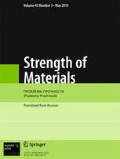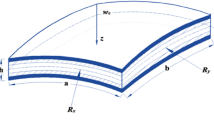Free and fixed plate blade root states were simulated with finite element analysis to reveal the crack effect on the natural vibration frequency of the blade. Natural vibration frequencies are obtained for blades with different crack locations and lengths. The crack is found to reduce the blade stiffness and to affect its natural vibration frequency. The longer the crack, the greater the change of the stiffness, and the more the natural vibration frequency decreases. In the free state, the effect of the cracks of the same length on the natural vibration frequency is basically identical when it lies between the two nodal lines of first-order bending vibrations. The crack effect at a height of one-half the blade in the free state on natural frequencies is very close to that of the cracks of the same length at a height of one-eighth the blade in the fixed state. Practical guidelines for the detection of fracture cracks are given and the crack length and location were evaluated by frequency variations.






Similar content being viewed by others
References
S. Li, L. Liang, and Q. Yu, “Theoretic study on inherent frequency of bending vibration of stepped beam,” J. Gansu Sci., 30, No. 4, 81–86 (2018).
Q. Sun, B. Wang, Q. Chai, et al., “The effects of the compressor blade fixed states to the nature frequency calculated results,” J. Air Force Eng. Univ.: Natural Science Edition, 4, No. 4, 8–10 (2003).
Q. Sun, Z. P. Zhang, C. W. Li, et al., “The study of the nature frequency for aero-engine pin fixed blade,” Chinese J. Appl. Mech., 23, No. 3, 470–472 (2006).
Q. Sun, Z. P. Zhang, Q. Chai, et al., “The relationship between the aero-engine compressor blade nature frequency and the temperature,” Chinese J. Appl. Mech., 21, No. 4, 137–139 (2004).
C. W. Li, H. Y. Li, C. Wang, et al., “A Study of influencing factors on frequencies and mode shapes of aeroengine turbine blades,” J. Air Force Eng. Univ.: Natural Science Edition, 15, No. 1, 5–9 (2014).
W. H. Cai, “Equivalent bending stiffness calculation for rotating blade crack section,” J. Jilin Univ., 32, No. 3, 41–44 (2002).
J. H. Kuang and B. W. Huang, “The effect of blade crack on mode localization in rotating bladed disks,” J. Sound Vib., 227, No. 1, 85–103 (1999).
O. Sadettin, “Analysis of free and forced vibration of a cracked cantilever beam,” NDT&E Int., 40, No. 6, 443–450 (2007).
Y. P. Fang, Vibration Model Analysis [in Chinese], National Defence Industry Publishing House, Beijing (1994).
ANSYS Help, Release 10.0 Documentation for ANSYS, ANSYS Inc., Pittsburgh, PA (2005).
C. W. Li, X. Q. Luo, B. Y. Yang, et al., “Stress intensity factor calculation for aero-engine compressor blade with finite method,” Chinese J. Appl. Mech., 30, No. 3, 373–377 (2013).
Acknowledgments
The authors gratefully acknowledge the financial support of the National Natural Science Foundation of China (Nos. 51575524, 51601221, and 61875231), Scientific Research Initiation Funds for the Doctoral Program of Xi’an International University, China (grant No. XAIU2018070109).
Author information
Authors and Affiliations
Corresponding author
Additional information
Translated from Problemy Prochnosti, No. 1, pp. 112 – 118, January – February, 2020.
Rights and permissions
About this article
Cite this article
Li, C.W., Li, J. & Fang, Y.W. Simulation of the Crack Geometry Effect on the Natural Vibration Frequency of a Plate Blade. Strength Mater 52, 97–102 (2020). https://doi.org/10.1007/s11223-020-00154-1
Received:
Published:
Issue Date:
DOI: https://doi.org/10.1007/s11223-020-00154-1




